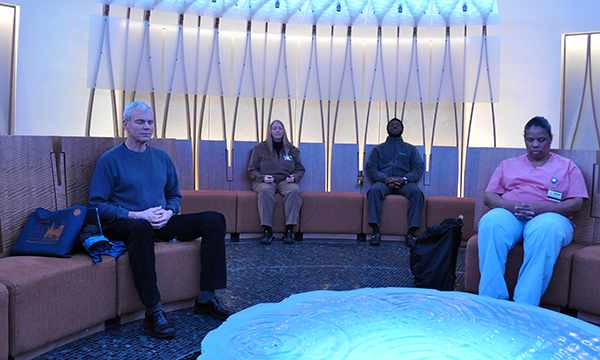
19 May Stress Has Left the Building—Without You Having to Do Likewise
Some days, no matter how much you love your job, don’t you wish you could just walk away? Even for a few minutes just to clear your head? Dealing with all the details, demands and decisions can be taxing.
In my own situation working in a home-based office, sometimes I just go out on the back deck and do a few jumping jacks to untangle the ideas or issues.
Or I walk through our garden, not necessarily looking for answers but to defuse all the answers I’ve been dealing with that day.
It’s important to have an outlet where the brain can breathe.
Being a Feng Shui consultant in hospitals has opened me up to the importance of having a place where patients, visitors and, just as importantly, employees can go to de-compress.
These areas are known by various names:
- Chapels
- Prayer rooms
- Meditation rooms
- Quiet rooms.
They are all intended to support someone’s journey. Typically, they’re not focused in any religious direction, but instead provide a space for reflection, private prayer, or simply breathing.
When I was involved with assuring that the Quiet Room in one hospital was fulfilling the aspects of a true Integrative Space, I was told that the majority of people who go in this room were not patients or even visitors– — but the staff.
On a break, walking down the hall, over lunch, or just needing some time to breathe, employees were seeing refuge for a few moments. They were bringing themselves back to what was important and tuning into their own point of balance.
In creating this Quiet Room or any quiet area, I make sure that all Feng Shui elements of nature are represented in either a literal or figurative way. When someone, patient or employee alike, is infused with a universal statement like this regarding the balance of nature, it increases their success in getting back on track.
Here are some specific Feng Shui aspects of the room to pay attention to in order to create a successful quiet area:
- Lighting is key– -keeping it low enables people to go within a little easier
- Seating that is comfortable yet keeps a person from sprawling out into a nap
- An experience of flowing water, real or implied
- Something round to express wholeness (rug, table, artwork)
- Flowers, plants or photographs in lieu of the real thing.
The concept of a Quiet Room or Meditation Room has become a standard feature in most hospitals. Certainly, visitors and patients appreciate the opportunity for reflection but, truth be known, the staff are the ones who take advantage of it the most.
